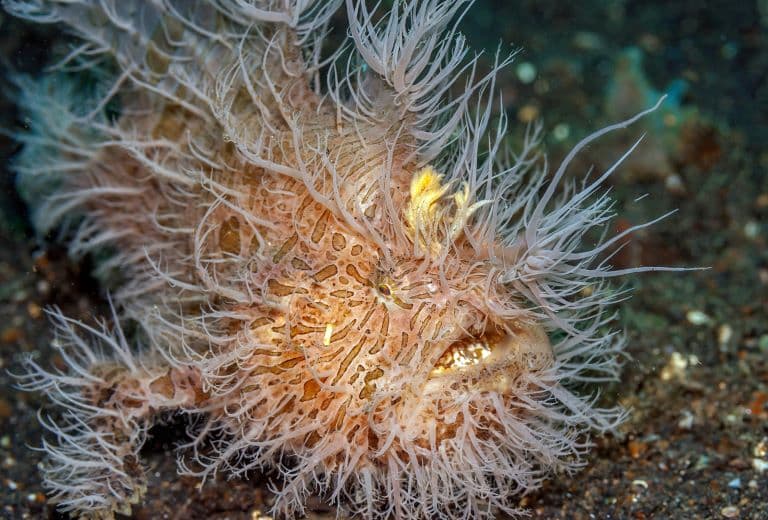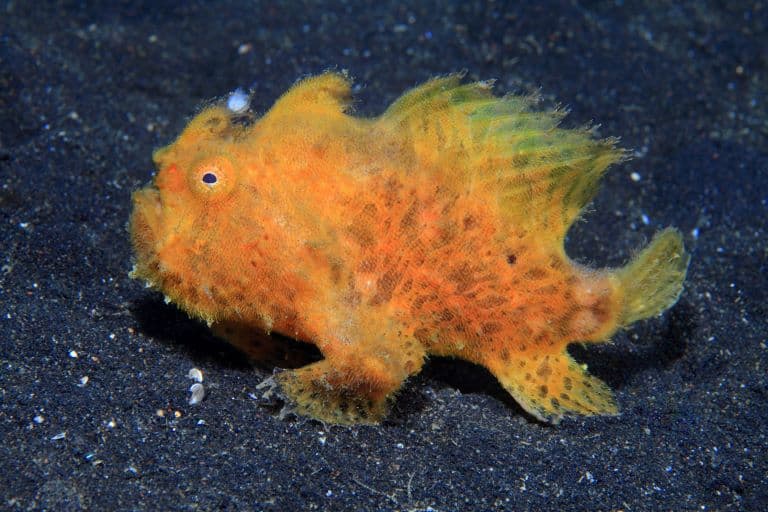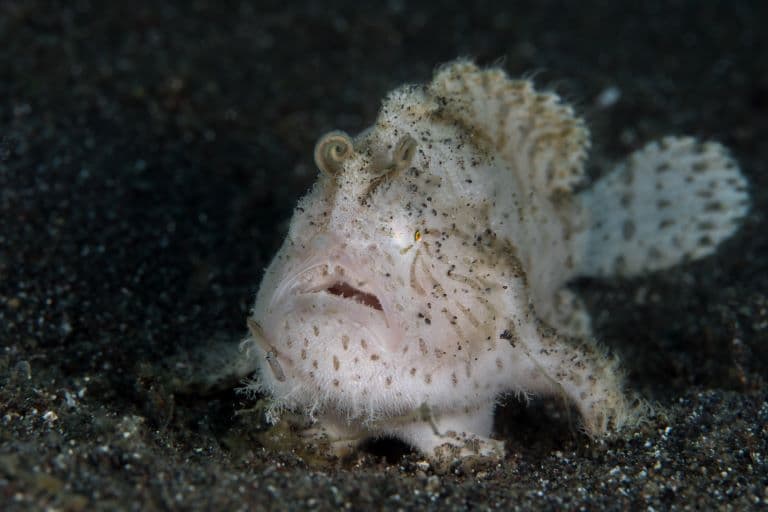Hairy Frogfish Profile
Animals camouflage themselves in a number of ways. Sometimes they want to look like something more dangerous, other times they want to look like something so innocuous that it’s of no interest at all.
The hairy frogfish does both of these things, but it does so while looking like a gobstopper that’s been rolled across an old carpet.
This is an exceedingly common animal, found in shallow waters all over the world, yet, it’s so good at what it does, that few people ever get lucky enough to spot one in the wild.

Hairy Frogfish Facts Overview
| Habitat: | Shallow, sandy areas or rocky and coral reef |
| Location: | Worldwide except Mediterranean and Arctic |
| Lifespan: | Unknown |
| Size: | Up to 25 cm (9.8 in) long. |
| Weight: | Around 250g (9 oz) |
| Colour: | Can be yellow, brownish-orange, green, gray, brown, white, or black |
| Diet: | Small marine fish and crustaceans |
| Predators: | Few, possibly some sharks |
| Top Speed: | Slow |
| No. of Species: | Unknown/species complex |
| Conservation Status: | Least Concern (IUCN) |
The hairy frogfish is one of the strangest fish you’ll never see. It’s exceptionally camouflaged, slow-moving and lumbering until it gets near a hapless victim, then it’s one of the fastest animals on the planet.
They’re angler fish, so they have lures on their heads, but they are so well camouflaged they don’t need to retreat to the murky depths.
Their mimicry is useful as a predator and prey, as their similarity to urchins and anemones keeps predators away, too.
They’re found almost all over the world, though some of these populations may come out as new species with time.
Interesting Hairy Frogfish Facts
1. They’re anglerfish
All frogfishes are a member of the anglerfish order, and make up the family Antennariidae. As the name suggests, they have a protrusion, formed from one of the dorsal spines near the head, and this is what the classic deep sea monsters use as a luminous lure to catch their prey.
Hairy frogfish have one, too, but they hunt in the shallows during the day, so a light isn’t necessary. Instead, they have a kinda of gross, wiggly worm-like thing dangling off the end of theirs, which is exactly what other fish find the most appealing.
As a species, they seem to vary quite a bit in terms of colour and location, but this might be because they’re more genetically diverse than we currently have on record.

2. They’re a species complex
The hairy frogfish is found pretty much all over the world and comes in a variety of colours. This might be, in large part, because it’s not a single species.
This animal is currently listed as a “species complex” which is basically a term that means “we haven’t figured out their systematics yet”.
They’re clearly closely related, and it’s possible they’re a single species with various populations and subspecies found in various places, but there’s a chance at least that some of them are totally different species.
For now, they’re all grouped under Antennarius striatus, but once genetic analyses get around to them, you can expect this to change a little.
3. They’re good at pretending
Aside from pretending to be a single species, these fish also mimic a bunch of other things, too.
The hairiness that gives them their name comes from the modified skin spines that have become elongated and frilly, giving them the appearance of a worn-out rug.
But they also look a lot like all the algae and various detritus that you’d expect to find growing on or blowing about the reef where they hunt.
This is obviously useful for an ambush predator, but even scary animals like this have larger, even scarier enemies. And the frogfish doesn’t have a lot going for it in terms of chemical or physical defence, so it also happens to look a bit like things that do.
The patterns and protrusions on this fish look suspiciously like sea anemones, which are notoriously spicy animals that few things like to eat. So while it mimics rocks and algae, it also presents aggressive mimicry of venomous animals, too. 1

4. They can inflate
When the camo isn’t working, this fish does have one thing up its sleeve. Like porcupine and puffer fishes, it can swallow copious amounts of water to rapidly inflate and hopefully make it too much of a mouthful for whatever was going to eat it.
There’s some evidence they can do this with air, too, but these fish are so crap at swimming they’re not often found anywhere near the surface. 2
5. They’re slow
The fins of the hairy frogfish aren’t really fit for purpose when it comes to swimming. They’re better at pulling the animal along the sea bed, so that’s mostly how these fish get around.
Frogfish can be seen “walking” on these fins, as well as being tossed about clumsily by the currents. They do occasionally swim, but this is usually saved for a “nuptial” trip to the surface where males and females will release their respective oozings into the water together.
But all of this lumbering mal-coordination collapses the second the frogfish finds prey. 3
6. Until they bite
You’d think an animal like this would be extinct by now since it’s barely more mobile than a piece of loose seaweed.
But while it can’t swim well, all the character points that weren’t put into camouflage have been stored in its snap.
This fish sits patiently, waggling its little worm and waiting for victims to stray too close to its mouth. At this point, it snaps so fast that slow-motion video is more or less redundant.
It’s said the hairy frogfish can close its jaws at 1/6000th of a second, which makes it one of, if not the, fastest bites in the animal kingdom. 4

Hairy Frogfish Fact-File Summary
Scientific Classification
| Kingdom: | Animalia |
| Phylum: | Chordata |
| Class: | Actinopterygii |
| Order: | Lophiiformes |
| Family: | Antennariidae |
| Genus: | Antennarius |
| Species: | striatus |
Fact Sources & References
- (2012), “The amazing mimicry of frogfish”,.
- “Longlure Frogfish”, Florida Museum.
- Storyful Viral (2017), “Two Hairy Frog-Fish Take a Walk”, YouTube.
- Smithsonian Channel (2020), “This Hairy Frogfish’s Bite is Too Fast For Slow-Motion”, YouTube.
